新结构经济学 重构发展经济学的框架 PPT
新发展经济学PPT教学课件

§4. 旧发展经济学与新发展经济学
一、发展问题:
1、发展中国家的经济相对于发达国家为什么落后或不 发达?即,不发达的原因和障碍是什么?
2、发展中国家如何加快经济发展步伐来追赶发达国家? 即,应采取何种策略推进经济发展?
二、战后50多年来形成的发展经济学,只是“发展 中 国家的经济学”
1、增长理论的兴起(从斯密到哈罗德-多马)
a) 存在性 : dk=0 s·f(k)=nk 实现充分就业 b) 稳定性 : sf(k)>nk dk>0 k↑→k*
sf(k)<nk dk<0 k↓→k* • 4.推广
a) 折旧 dk=sf(k)-(n+δ)k b) 技术进步 dk=sf(k)-(δ+n+g)k • 5.黄金定律: f-1(k)=n;
§6. 后发优势及其变化趋势
1、后发优势:经济发展相对落后/迟缓所形成的有利条件或机遇。 Late-developing Advantage(LDA)
①技术性后发优势:后发国通过技术引进、学习模仿所获得的利益。 ②制度性后发优势:制度和政策层面的学习模仿所获得的经济利益,如
制度借鉴 2、学习成本 ①WHO(学习主体):个人,单位,地区,国家 ②WHAT:技术,制度,政策,经验,发展经历 ③HOW :a)模仿式学习:程序式的
• 技术性EDA:一国技术创新领先,推出新产品 • 制度性EDA:政策性因素、规则的变化、制度创新带来发展动力
2、创新成本 Innovation cost(IC) • 直接成本:可用货币计量的创新所需的成本 • 间接成本(机会成本):所需时间、资源、人力等不能用于其它方面
的成本
3、英国案例
4、美国案例
– 第一阶段:各种经济增长模型提出 40S-60S – 第二阶段:因素分析 60S – 第三阶段:增长极限论 70S “罗马俱乐部”
2024版《发展经济学》ppt课件

•发展经济学概述•发展中国家经济发展现状与问题•经济发展理论与政策•全球化与经济发展目录•可持续发展与经济发展•创新、创业与经济发展01发展经济学概述发展经济学的定义与特点定义:发展经济学是研究发展中国家经济增长、经济发展、经济转型以及相关政策与战略的学科。
强调经济增长与经济发展的内在联系。
重视政策分析与实证研究。
01 02 031 2 301 02 030102起源20世纪50年代至60…20世纪70年代至80…20世纪90年代至今未来展望030405发展经济学的历史与发展02发展中国家经济发展现状与问题发展中国家的经济发展现状经济增长迅速许多发展中国家在过去几十年中实现了显著的经济增长,特别是在亚洲和非洲地区。
产业结构多样化发展中国家的产业结构正在从以农业为主向制造业和服务业转变,尤其是信息技术、金融和旅游等领域。
城市化进程加速随着工业化和现代化的推进,发展中国家的城市化进程正在加速,城市人口比例不断上升。
发展中国家面临的主要问题贫困和不平等基础设施落后教育和卫生问题环境问题发展中国家的经济发展战略促进经济增长推进教育和卫生事业发展A B C D加强基础设施建设实施可持续发展战略03经济发展理论与政策经济发展的概念、特点、与经济增长的区别与联系。
经济发展的定义与内涵从重商主义、古典经济学、新古典经济学到发展经济学的理论演变。
经济发展理论的演进结构主义、新古典主义、激进主义等流派的主要观点和政策主张。
经济发展理论的流派经济发展理论概述产业政策财政政策货币政策社会政策经济发展政策的主要内容经济发展政策的实践与效果发展中国家的经济发展实践东亚奇迹、拉美债务危机、非洲贫困化等案例的分析。
发达国家对发展中国家的援助政策援助方式、援助效果及存在的问题。
全球化对发展中国家的影响及应对策略全球化带来的机遇与挑战,以及发展中国家的应对策略。
未来经济发展趋势及政策建议基于当前全球经济形势,预测未来经济发展趋势,并提出相应的政策建议。
2024年发展经济学课件(含多款)

发展经济学课件(含多款)发展经济学课件引言发展经济学是一门研究发展中国家经济问题的学科,旨在探讨如何通过经济手段实现国家的现代化和繁荣。
本课件将介绍发展经济学的基本概念、理论框架和主要议题,帮助读者更好地理解和应用发展经济学的知识。
第一部分:发展经济学的基本概念1.1发展与发展经济学发展是指一个国家或地区经济、社会、文化等方面的进步和改善。
发展经济学是研究发展中国家经济问题的学科,关注的是如何通过经济手段实现国家的现代化和繁荣。
1.2经济增长与经济发展经济增长是指一个国家或地区总体经济规模的扩大,通常用国内生产总值(GDP)来衡量。
经济发展不仅包括经济增长,还包括经济结构的变化、社会福利的提高、教育和技术进步等方面的进步。
1.3贫困和不平等贫困是指个人或家庭缺乏基本生活需求的状态,如食物、住所、教育和医疗等。
不平等是指收入、财富、教育、机会等方面的差异。
发展经济学关注如何减少贫困和不平等,实现更加公平和可持续的发展。
第二部分:发展经济学的理论框架2.1结构主义理论结构主义理论认为,发展中国家的经济问题是由于经济结构的僵化和不平衡导致的。
因此,应该通过调整经济结构、推动工业化和现代化来实现经济发展。
2.2依赖理论依赖理论认为,发展中国家的经济问题是由于对外部发达国家的依赖和不平等的国际经济秩序导致的。
因此,应该通过减少对外部发达国家的依赖、推动南南合作和建立公平的国际经济秩序来实现经济发展。
2.3新古典主义理论新古典主义理论认为,发展中国家的经济问题是由于市场失灵和政府干预不当导致的。
因此,应该通过市场化和私有化改革、加强产权保护和推动自由贸易来实现经济发展。
第三部分:发展经济学的主要议题3.1贸易与全球化贸易和全球化对发展中国家的经济发展有着重要的影响。
发展中国家应该通过积极参与国际贸易、吸引外国直接投资和加强国际合作来促进经济发展。
3.2农业、农村发展与城市化农业是发展中国家经济的重要组成部分,农村发展对于减少贫困和提高社会福利具有重要意义。
发展经济学结构篇课件

缺陷
现代部门工资商品完全自给,农业的落后和贫困不会成为经 济增长的障碍,忽略了农业部门发展和整个经济的粮食供应 问题。
刘易斯模型假定农村存在失业,而城市不存在失业,流入城 市农村劳动力都能找到劳动力,事实上城市存在大量城市贫 民。
刘易斯只注重现代部门的供给分析,认为劳动力无限供给的 假设下,资本主义部门发展的唯一约束是储蓄,忽视了需求 不足对经济增长的影响。
刘易斯模型的改进1
假定:
经济体是封闭的,资本主义部门和传统部门与外部世界都没有发 生贸易
资本主义部门和传统部门相互贸易,资本主义部门依赖于农业部 门提供食物、原料和市场
推论:
在资本主义部门扩大的情况下,必然会增加这个部门对食物的需 求,在供给一定的情况下,食物需求的增加会增加食物的价格, 从而导致工资上涨
非资本主义部门主要由传统农业部门组成,在整个社会中占绝大部分, 生产方式落后,劳动生产效率低下,技术进步处于停滞状态 。
生产的产品用于部门内部消费,生产投资非常少,不存在工资劳动力者, 生产的目的仅仅是为了生存。
人均收入维持在生存水平上,仅仅能保证人口的再生产(土地收益递减 规律和马尔萨斯的人口规律)。
经典的经济发展理论在传统农业部门不能发挥作用。
在这种情况下
工业部门如何发展? 劳动力以什么样的机制转移?
二元经济条件的两个基本特征
现代部门的工生存所需要的最低 费用
现代部门的生活成本较高,工会的力量,吸引劳动力 加入,转移劳动力的心理成本
要使农产品价格稳定,农业生产必须同步增长。
刘易斯模型的改进2
假定:
经济体是开放的,资本主义部门和传统部门与外部世 界发生贸易
推论:
《发展经济学》PPT课件共10文档

注重实证分析,运用现代经济学理论和方 法研究发展中国家的经济问题。
强调经济发展的多元性、动态性和长期性。
特点
以发展中国家为研究对象,关注其经济增 长、经济发展、贫困、不平等等问题。
发展经济学的研究对象与任务
01
研究对象:发展中国家及其经济发展过程中的各种问题,如 经济增长、经济结构变化、贫困与不平等、资源与环境等。
经济发展阶段理论
罗斯托的经济发展阶段论
将经济发展分为传统社会、起飞前准备、起飞、成熟和高额消费等阶段,强调 不同阶段的特征和转换条件。
钱纳里的工业化阶段理论
根据人均收入水平将工业化进程分为初级产品生产、工业化初期、工业化中期 和工业化后期等阶段,揭示不同阶段的经济结构变化。
经济发展中的结构变化
1 2 3
03
CATALOGUE
经济发展中的资本积累与投资
资本积累在经济发展中的作用
促进经济增长
资本积累是经济增长的重要因素之一,通过增加生产要素的投入, 提高生产效率,从而促进经济增长。
提升技术水平
资本积累可以推动技术进步和创新,通过引进新技术、新设备和新 工艺,提高生产的技术水平,降低成本,增强竞争力。
促进资源有效配置
制度通过产权保护、市场规则等手段,促进资源的有效配置,提高 经济效率。
激励创新和企业家精神
制度通过知识产权保护、激励机制等措施,鼓励创新和企业家精神, 推动技术进步和产业升级。
政策对经济发展的影响
财政政策
政府通过财政支出和税收政策,调节总需求,影响经济增长、就 业和物价稳定。
货币政策
探索新的理论和方法,为发 展中国家的经济发展提供智 力支持。02CA源自ALOGUE经济发展理论与模型
林毅夫——新结构经济学

经 济 学 季 刊 $ % & ' () * + ' + , & *. ( / 0 1 / 2 3
4 + 2 5 ! "6 + 5 ! 7 * 0 + 8 1 / # " ! "
新结构经济学
重构发展经济学的框架 林毅夫 !
摘 要 " 经济 发 展 本 质 上 是 一 个 技 术 产 业 不 断 创 新 结 构 不 断变化的过程 发展 经 济 学 在 二 战 后 刚 成 为 现 代 经 济 学 中 的 一 个 分 支时 结构主义的 观 点 占 主 流 认 为 经 济 结 构 外 生 决 定 强 调 市 场 失灵及政府在改 变 经 济 结 构 促 进 经 济 发 展 中 的 作 用 由 于 结 构 主 义所主张的以政府主导产业结构升 级 的政 策在发展 中国 家 普 遍 失 败 到了 # " 世纪 9 " 年 代 以 后 发 展 经 济 学 转 而 以 华 盛 顿 共 识 为 主 流 强调政府失灵 片 面 侧 重 市 场 的 作 用 并 且 忽 视 了 对 结 构 及 其 变 迁 问题的研究 本文 提 出 新 结 构 经 济 学 的 理 论 框 架 认 为 经 济 结 构 内 生决定于要素禀 赋 结 构 并 倡 导 以 新 古 典 经 济 学 的 方 法 来 研 究 经 济 结构及其变迁 以 及 政 府 市 场 在 此 过 程 所 起 的 作 用 以 弥 补 当 前 发展经济学的不足
! 历史经验告诉我们 # 这次危机所造成的影响 # 可能远比危机本身更加持久 &
发展经济学-整本书课件完整版电子教案全套课件最全教学教程ppt(最新)

哈罗德-多马模型: 均衡的稳定性问题
“刀刃上的均衡”
– 实际的资本-产出比率与企业家意愿的资本-产出比率 不一致。
– 实际增长率与有保证的增长率不一致。 – 当实际增长率与有保证的增长率发生偏离时,不但不
能自行纠正,反而会产生更大的偏离,使经济过度扩 张或收缩。
决定的自然增长率与有保证的 增长率不一致。
哪些国家是发展中国家
要确定哪些国家是发展中国家,一个比较方便的 办法是先弄清楚哪些国家是发达国家。 经济发展与合作组织(OECD)常被人们称为 “发达国家俱乐部”。不过有些发达国家(地区) 并不是OECD成员,也并非所有OECD成员都是 发达国家。 发展中国家主要分布在亚洲、非洲和拉丁美洲。 中国是世界上最大的发展中国家。
– 经济中并不存在任何一种机制使这两种增长率必然相 等。
哈罗德-多马模型:政策含义
以简洁的方式强调了储蓄和资本形成对经 济增长的决定作用。 仅靠市场的作用很难达到经济的动态稳定 和充分就业增长。 被广泛用于发展中国家的增长计划中。
哈罗德-多马模型:局限
固定要素比例生产函数假设
– 资本与劳动能否相互替代,并非技术问题而是经济问 题
1980 1981 1982 1983 1984 1985 1986 1987 1988 1989 1990 1991 1992 1993 1994 1995 1996 1997 1998 1999 2000 2001 2002 2003
综合发展指标
优点:较为全面地反映发展状况 缺点:
– 计算起来较为困难 – 子指标的选择具有一定的随意性 – 各项子指标的权重并无理论根据
– 市场分割 – 交易成本过高 – 缺乏法律和其他制度的支持
发展中国家的政府对经济的干预程度较高, 压抑了市场发育。
新结构经济学重构发展经济学的框架

新结构经济学重构发展经济学的框架一、本文概述本文旨在探讨新结构经济学如何重构发展经济学的框架,从而为全球范围内的经济发展提供新的理论指导和政策启示。
新结构经济学作为一种新兴的发展经济学理论,强调了结构转型和产业升级在经济发展中的核心地位,突破了传统发展经济学的一些局限。
本文将首先概述新结构经济学的基本理念,然后分析其在重构发展经济学框架中的关键作用,最后讨论新结构经济学对发展中国家的实际指导意义。
通过深入研究新结构经济学的理论框架和实践应用,我们希望能够为发展经济学的研究和实践提供新的视角和思路。
二、新结构经济学的基本理论新结构经济学,作为一种全新的发展经济学理论,其基本理论框架主要围绕“结构决定发展”的核心思想展开。
它强调,一个国家或地区的经济结构,包括产业结构、技术结构、劳动力结构、金融结构等,对其经济发展具有决定性的影响。
因此,新结构经济学主张,在制定经济政策和发展战略时,必须充分考虑并适应这些结构性特征。
新结构经济学认为,市场机制和政府作用在经济发展中都具有重要作用,但二者的角色和作用方式需要根据经济发展的不同阶段和结构性特征进行调整。
在市场机制方面,新结构经济学强调市场的决定性作用,认为市场能够有效配置资源,推动创新和产业升级。
同时,新结构经济学也重视政府在经济发展中的作用,特别是在基础设施建设、公共服务提供、市场监管等方面。
新结构经济学还提出了“比较优势发展战略”的理念。
它认为,每个国家或地区都有其独特的资源禀赋和发展条件,因此,在制定发展战略时,应当充分发挥自身的比较优势,选择适合自身发展的产业和技术路径。
同时,新结构经济学也强调,比较优势并不是静态的,而是可以通过学习和创新来不断提升和转变的。
新结构经济学还关注经济发展的可持续性和包容性。
它认为,经济发展不仅要追求速度和规模,更要注重质量和效益,要实现经济、社会、环境的协调发展。
新结构经济学也强调,经济发展应当惠及广大人民群众,要减少贫富差距,促进社会公平和和谐。
新结构经济学 ppt课件

Market based economies with proactive role for government
Rethink Development
Structuralist Approach Focus on Market Failures: Import Substitution Strategy
• Sustainable income growth is a recent phenomenon
30,000 25,000 20,000 15,000 10,000
5,000 0
1 1000 1500 1600 1700 1820 1870 1913 1950 1973 2001
Western Europe Western Offshoots Eastern Europe Former USSR Latin America Japan Asia excl. Japan Africa
• The sustainable income growth is a result of continuous technological
innovation as well as structural change
9
Industrial Structure in New England, 1900s
Export Orientation and Market Friendly
新结构经济学——重构发展经济学的框架
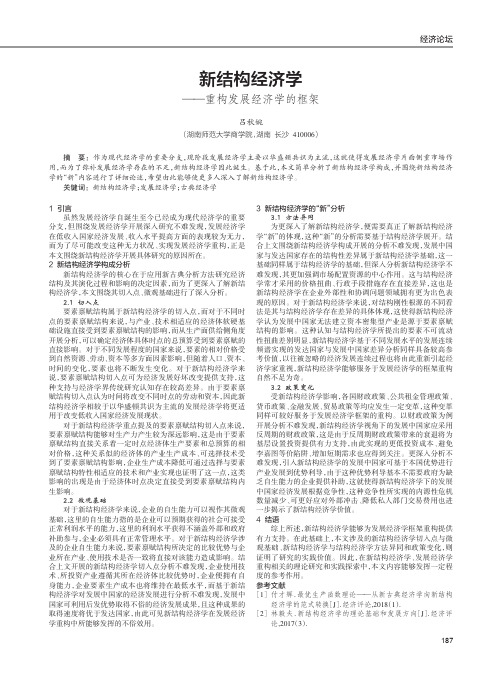
经济论坛新结构经济学——重构发展经济学的框架吕秋婉(湖南师范大学商学院,湖南长沙410006)摘要:作为现代经济学的重要分支,现阶段发展经济学主要以华盛顿共识为主流,这就使得发展经济学片面侧重市场作用,而为了弥补发展经济学存在的不足,新结构经济学因此诞生。
基于此,本文简单分析了新结构经济学构成,并围绕新结构经济学的“新”内容进行了详细论述,希望由此能够使更多人深入了解新结构经济学。
关键词:新结构经济学;发展经济学;古典经济学1引言虽然发展经济学自诞生至今已经成为现代经济学的重要分支,但围绕发展经济学开展深入研究不难发现,发展经济学在低收入国家经济发展、收入水平提高方面的表现较为无力,而为了尽可能改变这种无力状况、实现发展经济学重构,正是本文围绕新结构经济学开展具体研究的原因所在。
2新结构经济学构成分析新结构经济学的核心在于应用新古典分析方法研究经济结构及其演化过程和影响的决定因素,而为了更深入了解新结构经济学,本文围绕其切入点、微观基础进行了深入分析。
2.1切入点要素禀赋结构属于新结构经济学的切入点,而对于不同时点的要素禀赋结构来说,与产业、技术相适应的经济体软硬基础设施直接受到要素禀赋结构的影响,而从生产面供给侧角度开展分析,可以确定经济体具体时点的总预算受到要素禀赋的直接影响。
对于不同发展程度的国家来说,要素的相对价格受到自然资源、劳动、资本等多方面因素影响,但随着人口、资本、时间的变化,要素也将不断发生变化。
对于新结构经济学来说,要素禀赋结构切入点可为经济发展好坏改变提供支持,这种支持与经济学界传统研究认知存在较高差异。
由于要素禀赋结构切入点认为时间将改变不同时点的劳动和资本,因此新结构经济学相较于以华盛顿共识为主流的发展经济学将更适用于改变低收入国家经济发展现状。
对于新结构经济学重点提及的要素禀赋结构切入点来说,要素禀赋结构能够对生产力产生较为深远影响,这是由于要素禀赋结构直接关系着一定时点经济体生产要素和总预算的相对价格,这种关系似的经济体的产业生产成本、可选择技术受到了要素禀赋结构影响,企业生产成本降低可通过选择与要素禀赋结构特性相适应的技术和产业实现也证明了这一点,这类影响的出现是由于经济体时点决定直接受到要素禀赋结构内生影响。
New structural economics --a framework for rethinking development
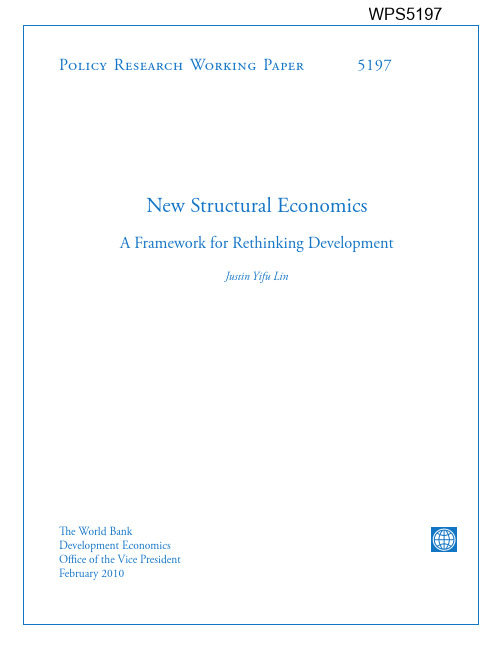
Policy Research Working Paper 5197New Structural EconomicsA Framework for Rethinking DevelopmentJustin Yifu LinThe World Bank Development Economics Office of the Vice President February 2010WPS5197AbstractThe Policy Research Working Paper Series disseminates the findings of work in progress to encourage the exchange of ideas about developmentissues. An objective of the series is to get the findings out quickly, even if the presentations are less than fully polished. The papers carry thenames of the authors and should be cited accordingly. The findings, interpretations, and conclusions expressed in this paper are entirely thoseof the authors. They do not necessarily represent the views of the International Bank for Reconstruction and Development/World Bank andPolicy Research Working Paper 5197As strategies for achieving sustainable growth in developing countries are re-examined in light of the financial crisis, it is critical to take into account structural change and its corollary, industrial upgrading. Economic literature has devoted a great deal of attention to the analysis of technological innovation, but not enough to these equally important issues. The new structural economics outlined in this paper suggests a framework to complement previous approaches in the search for sustainable growth strategies. It takes the following into consideration: First, an economy’s structure of factor endowments evolves from one stage of development to another. Therefore, the optimal industrial structure of a given economy will be different at different stages of development. Each industrial structure requires corresponding infrastructure (both “hard” and “soft”) to facilitate its operations and transactions.This paper—a product of the Office of the Vice President, Development Economics—is part of a larger effort in the department to revisit strategies for achieving sustainable growth in developing countries. Policy Research Working Papers are also posted on the Web at . The author may be contacted at research@.Second, each stage of economic development is a point along the continuum from a low-income agrarian economy to a high-income industrialized economy, not a dichotomy of two economic development stages (“poor” versus “rich” or “developing” versus “industrialized”). Industrial upgrading and infrastructure improvement targets in developing countries should not necessarily draw from those that exist in high-income countries. Third, at each given stage of development, the market is the basic mechanism for effective resource allocation. However, economic development as a dynamic process requires industrial upgrading and corresponding improvements in “hard” and “soft” infrastructure at each stage. Such upgrading entails large externalities to firms’ transaction costs and returns to capital investment. Thus, in addition to an effective market mechanism, the government should play an active role in facilitating industrial upgrading and infrastructure improvements.NEW STRUCTURAL ECONOMICSA Framework for Rethinking Development1Justin Yifu LinSenior Vice President and Chief EconomistWorld Bank1The main arguments of this paper were presented at DEC’s fourth Lead Economists Meeting and at Lin’s first anniversary at the Bank on June 2, 2009. A shorter version of this paper was presented at the conference on “Challenges and Strategies for Promoting Economic Growth”, organized by the Banco de México at Mexico City on October 19-20, 2009; and at public lectures in Cairo University on November 5, 2009, Korean Development Institute on November 17, 2009, OECD on December 8, 2009, UNU-WIDER on January 19, 2010, and Stockholm Institute of Transitional Economics on January 21, 2010. Celestin Monga provided invaluable help in preparing this paper. The paper also benefits from discussions and comments from Gary Becker, Otaviano Canuto, Ha-Joon Chang, Luiz Pereira Da Silva, Augusto de la Torre, Christian Delvoie, Asli Demirgüç-Kunt, Shantayanan Devarajan, Hinh T. Dinh, Shahrokh Fardoust, Ariel Fiszbein, Robert Fogel, Alan Gelb, Indermit S. Gill, Ann Harrison, James Heckman, Aart Kraay, Auguste Tano Kouame, Norman V. Loayza, Frank J. Lysy, Shiva S. Makki, William F. Maloney, Mustapha Kamel1. INTRODUCTIONThe global crisis that started in the U.S. financial sector in the fall of 2008 is the most serious one both in terms of magnitude and scope since the Great Depression. No country has been immune to the economic slowdown. World GDP contracted 2.2 percent in 2009, the first time after World War II (WWII), and world trade volumes fell by a staggering 14.4 percent, the largest in 80 years (World Bank 2010).Prior to the crisis, World Bank research estimated the number of people living below the poverty line worldwide at about 1.4 billion in 2005 (living on less than $1.25 a day). It is now expected that the cumulative impact of the crisis will deprive some 64 million people the opportunity of getting out of poverty by 2010, most of them in countries that have already been riddled with poverty (Chen and Ravallion 2009). The experience of previous crises makes it seem likely that the impacts may even be more long-lasting than the crisis itself.2However, several decades from now when economic historians look back on the story of the past hundred years, it is very likely that they will be more intrigued by the mystery of diverging performances by various countries, especially during the second half of the twentieth century. On the one hand, they will be amazed by the rapid growth path followed by a small number of countries such as Brazil, Chile, China, Indonesia, India, Korea, Malaysia, Mauritius, Singapore, Thailand and Vietnam, where the industrialization process quickly transformed their subsistence, agrarian economies and lifted several hundred million people out of poverty in the space of one generation. On the other hand, they will be puzzled by the apparent inability of many other countries, where more than one-sixth of humanity (the “bottom billion,” as Collier (2007) put it) remained trapped in poverty. They will also notice that with the exception of a few successful economies,3 there was little economic convergence between rich and poor countries before the 2008-09 global crisis in spite of the many efforts made by developing countries and despite the assistance of many multilateral development agencies.The World Bank’s mandate is poverty reduction. Its dream is a world free of poverty. Long-term sustainable and inclusive growth is the driving force for poverty reduction. It is therefore crucial for economists at World Bank to understand the mechanics and determinants of economic growth. Development economics has provided us with some remarkable insights. But as a sub-discipline of economics, it has so far been unable to provide a convincing intellectual agenda for generating and distributing wealth in poor countries. The global crisis is an opportunity not only to identify new areas of research on how to help the developed and developing countries cope with the challenges of the crisis and prevent similar crises in the future, but also on how to achieve sustainable, inclusive growth to developing countries.This paper focuses on the long-term development challenges. It discusses the evolution of development thinking since the end of WWII and suggests a framework to enable developing countries to achieve sustainable growth, eliminate poverty, and narrow the income gap with the developed countries. The proposed framework, called a neoclassical approach to structures and change in the process of economic development, or new structural economics, builds on some of the 2 Empirical research on previous crises suggests that very young children seriously affected by poor nutrition may never catch up to their peers who were born in more fortunate times. In Indonesia, school enrollment fell after 1997 among the poorest; in rural areas the number of children 7-12 years old not enrolled in school doubled to 12 percent in a few years. The crisis also affected health outcomes; infant mortality increased by over 3 percentage points during the crisis.3 See for example, those 13 economies studied in the Growth Report (World Bank 2008).insights from the old school of structural economics. It emphasizes the idea that structural features need to be taken into account in the analysis of: (i) the economic development process; and (ii) the role of the state as a facilitator that helps a developing country convert its backward structure to a modern one. But this new framework also considers structural differences between developed and developing countries to be in large part endogenous to their endowment structures and determined by market forces, rather than resulting from the distribution of power or other exogenously determined rigidities as assumed by the old structural approach.The main approach is organized around the following ideas:•First, the economy’s factor endowments and their structure (defined as the relative abundance of natural resources, labor, human capital and physical capital) are given at any specific stage of development and differ from one stage to another. Therefore, the optimal industrial structure of the economy will be different at different stages of development. In addition to differences in the capital intensity of industries, different industrial structures imply differences in optimal firm size, scale of production, market range, transaction complexity, and also different nature of risks. As a result, each industrial structure requires corresponding soft and hard infrastructure4 to facilitate its operations and transactions.5•Second, each stage of economic development is a point in a wide spectrum from a low-income, subsistence agrarian economy to a high-income industrialized economy. Thus, the usual dichotomy between two economic development stages (“poor” versus “rich” or “developing countries” versus “industrialized countries”) is not useful. Given the endogeneity of industrial structure at each stage of development, the targets of industrial upgrading and infrastructure improvement in a developing country should not necessarily refer to the industries and infrastructure that are in place in high-income countries.•Third, at each given stage of development, the market is the fundamental mechanism for effective resource allocation. In addition, economic development as the dynamic process of moving from one stage to the next requires industrial diversification, upgrading, and corresponding improvements in hard and soft infrastructure. The process of industrial diversification and upgrading is a process of innovation. Pioneering firms in the diversification and upgrading process generate public (non-rival, non-excludable) knowledge to other firms in the economy, that is, consumption of the new knowledge by one firm does not reduce availability of that knowledge for others and no one can be effectively excluded from using it. In most cases, improvements in infrastructure cannot be internalized in an individual firm’s investment decision. Yet they yield large externalities to other firms’ transaction costs. Thus, in addition to an effective market mechanism, the government should play an active, facilitating role in the industrial diversification and upgrading process and in the improvement of infrastructure.4 Examples of hard infrastructure are power, transport and telecommunication systems. Soft infrastructure includes the financial system and regulation, education system, the legal framework, social networks, values and other intangible structures in an economy.5The optimal industrial structure determines the economy’s production frontier and whether or not the actual production will locate on the frontier depends on, among others, the adequacy of infrastructure.The implications of this framework for research are challenging. One needs to better understand the roles of the market and the state and how they interact to strengthen the private sector in the process of economic development. This poses several important questions: How can a successful development approach be designed and implemented to facilitate the smooth diversification and upgrading from one industrial structure to another? Where distortions exist because of excessive or insufficient interventions by governments, how can countries move to a first-best, distortion-free world? How can policymakers ensure that transitions work smoothly?The remainder of the paper is organized as follows: Section 2 examines the evolution of development thinking and offers a critical review of some of its main schools of thought. Section 3 outlines the basic principles and conceptual framework of the new structural economics, the function of the market, the four roles of a facilitating state, and the exit strategy from distortions. Section 4 highlights similarities and differences between old and new structural economics, and discusses some preliminary insights on major policy issues based on this new approach. Section 5 concludes with new structural economics’ implications for World Bank research.2. A SHORT REVIEW OF DEVELOPMENT THINKING AND EXPERIENCES6The process of sustainable per capita income increase and economic growth, characterized by continuous technological innovation and industrial upgrading, is a modern phenomenon. Before the modern era, most countries were in the development stage of a relatively backward agrarian economy—disturbed from time to time by war and natural calamities, and afflicted by the Malthusian trap. Except for the ruling classes, craftsmen and merchants—who represented a minority of the population—most people worked in subsistence agriculture, animal husbandry, or fishery. Given the technologies and industries prevalent at the time, the allocation of resources, developed through generations of practice in such economies, was close to optimal. Therefore, the gains from improvement in the allocation of resources were small (Schultz 1964). Further economic development was feasible only with some technological innovations, as an exogenous shock or an improvement based on experience, to the system.7 In this pre-modern era, economic development was manifested mainly in the form of population increase and the aggregate size of the economy. There was extensive growth, but per capita income did not change much (Clark 2007; Kuznets 1966; Perkins 1969).The income gap between areas that today would be considered developed and those that would be considered developing was relatively small from today’s viewpoint—estimated to be at most 50 percent (Maddison 2006; Bairoch 1993). Indeed, some of today’s developing countries—such as China and part of India—were believed to be richer than Europe at that time (Cipolla 1980; Pomeranz 2000; Smith 1776). Until the late eighteenth century, the overall performance of markets—in terms of integration—in China and Western Europe was comparable (Shiue and Keller 2007).6 These first four paragraphs draw heavily on Lin (2009a).7A few technological innovations before the modern times, such as the introduction of corn and sweet potato from America to the rest of the world, which were byproducts of the discovery of the new continent, can be analyzed as exogenous technological shocks. Most other technological innovations before modern times were the by-products from the daily practices of craftsmen or farmers.After the Industrial Revolution began in England in the mid-eighteenth century, experiments conducted in laboratories became the major source of technological invention and innovation (Lin 1995; Landes 1998). This was especially true for those macro-inventions that consisted of radical new ideas and involved large, discrete, novel changes, as defined by Mokyr (1990). For developed countries at the global technological frontier, such a transformation of the method of technological invention enabled them to accelerate technological advances through investment in research and development, and technological invention and innovation became endogenous (Romer 1986; Lucas 1988). With increasing investment in research and development, technology change accelerated, industrial structures upgraded continuously, and productivity increased. As a result, developed countries in the western hemisphere began to take off and the divergence between the North and the South appeared (Baumol 1994; Braudel 1984).Since 1820, the total output of advanced capitalist countries has increased seventy-fold, with population rising nearly five-fold, per capita product fourteen-fold and real per capita consumption almost tenfold.8 Figure 1 shows the evolution of per capita income in various regions of the world from 1 to 2001 AD, based on the estimation of Maddison (2006, p. 642). From an insignificant difference at the beginning of the eighteenth century, per capita income in the developed countries of Western Europe and its offshoots increased to more than 20 times that of the developing countries by the end of the twentieth century.9Figure 1: Per capita GDP of various regions, 1–2001 ADNote: Gross domestic product (GDP) is calculated with 1990 international Geary-Khamis dollar. The Geary-Khamis dollar—also known as the international dollar—is a sophisticated aggregation method of calculating purchasing power parity (PPP). This facilitates comparing countries with one another. The statistical definition can be found at /unsd/methods/icp/ipc7_htm.htmSource:Maddison, A. (2006). The World Economy. Paris: Organisation for Economic Cooperation and Development, 642.From Adam Smith to the early twentieth century, most economists believed that laissez faire was the best vehicle for achieving sustainable growth in an economy. It was assumed that in thriving economies, all decisions about resource allocation are made by economic agents interacting in markets free of government intervention. The price system determines not only what is produced and how but also for whom. Households and firms pursuing their own interests would be led, “as if8 See Maddison (1982).9 One caveat: As Lucas (1988) reflected in his 1985 Marshall Lectures, ‘[S]uch diversity across countries in measured per capita income levels is literally too great to be believed.’by an invisible hand,” to do things that are in the interests of others and of society as a whole. This thinking, made popular by Adam Smith, was based on economic experiences before the Industrial Revolution. It assumed that productivity increases in the agriculture and manufacturing sectors are due mainly to small, incremental refinement of old, traditional technologies for the purpose of exploiting widened markets and specialization and thus industries could be assumed as given in the analysis. It basically ignored the possibility of successive introduction of big innovations that create new industries or radically alter methods of production (Rostow 1990a).Although the laissez faire approach was challenged by Marxist economists and others, it became the dominant intellectual framework for the study of growth in all countries and remained so for a long time. It certainly provided many good insights on the process of economic development, including on the “role of the sovereign,” i.e., the state.10 But it had a major flaw: it missed the importance of the process of continuous, fundamental technological changes and industrial upgrading, which distinguishes modern economic growth from pre-modern economic growth (Kuznets 1966). That process may not be as spontaneous for a successful economy as implied by Marxist economics. Policymakers have always been obsessed with economic development, that is, the mechanics of organizing a country’s resources and institutions to produce and distribute more goods and services, and to sustain regular social progress and rising prosperity. Yet, what has come to be known as development economics is a relatively new sub-discipline of economics (Bell 1987). It took a paper by Rosenstein Rodan (1943) to bring development issues to the forefront of economics. The paper suggested that the virtuous circle of development depended essentially on the interaction between economies of scale at the level of individual firms and the size of the market. Specifically, it assumed that modern methods of production can be made more productive than traditional ones only if the market is large enough for their productivity edge to compensate for the necessity of paying higher wages. But the size of the market itself depends on the extent to which these modern techniques are adopted. Therefore, if the modernization process can be started on a very large scale, then the process of economic development will be self-reinforcing and self-sustaining. If not, countries will be indefinitely trapped in poverty.Rosenstein Rodan’s framework sparked a wave of similar ideas (Chang 1949; Lewis 1954; Myrdal 1957; Hirschman 1958), which came to be known as the structuralist approach to economic development. Its starting point was the fight against poverty, and the recognition that, in their quest for growth, developing countries face structural challenges that are different from those of high-income countries. It emerged from a context marked by two historical events and a major intellectual force: The Great Depression, the successful industrialization in the Soviet Union, and the rise of Keynesian economics, which stressed the importance of market failures and the need for an active government role in the economy. It was argued that, due to structural rigidities and 10 While Adam Smith is often perceived as a thinker who saw a limited role for the state in economic life, the reality is that he envisioned an important economic role for the state. Just like many leading theorists of free market economics, he believed that the state should enforce contracts and grant patents and copyrights to encourage inventions and new ideas. He also recommended that the state provide public works such as roads, bridges and defense—all things that, he assumed, would not be worthwhile for individuals to provide. However, he wanted the users of such public works to pay in proportion to their use (see The Wealth of Nations, Book V). Adam Smith did not discuss the role of state in industrial upgrading and the structural change endogenous to that process probably because the impact of industrial revolution only became observable and significant after his passed away in 1790.coordination problems in developing country markets, modern heavy industries were unable to develop spontaneously in a developing country.The market-failure thesis became the core of “development economics,” which emerged after World War II.11 Under the influence of Keynesianism and the belief in the economic success of the Soviet Union, mainstream theories in the early phase of development economics held that the market encompassed insurmountable defects and the state was a powerful supplementary means to accelerate the pace of economic development. Many development economists at that time advocated that the state should overcome market failures by playing a leading role in the industrialization push, directly allocating the resources for investment, and setting up public enterprises in the large heavy industries to control the “commanding heights” (Hirschman 1958; Nurkse 1953; Rosenstein-Rodan 1943).The slump of international trade in the Great Depression led to export pessimism in the Post-War period. In Latin America, for instance, political leaders and social elites were influenced strongly by the deterioration in the terms of trade, the economic difficulty encountered during the Great Depression in the 1930s, and the thesis developed by Prebisch (1950) and Singer (1950). They believed that the decline in the terms of trade against the export of primary commodities was secular, which resulted in the transfer of income from resource-intensive developing countries to capital-intensive developed countries. They argued that the way for a developing country to avoid being exploited by developed countries was to develop domestic manufacturing industries through a process known as import substitution.Moreover, the emergence of previous colonies or semi-colonies as newly independent states in Asia and the Middle East, and later in Africa, was accompanied by strong nationalist sentiments. Compared with developed countries, these developing countries had an extremely low economic growth rate and per capita gross national product, high birth and death rates, low average educational attainments, and very backward infrastructure. They were heavily specialized in the production and export of primary commodities and imported most of their manufactured goods. Thus, it was central to every developing country government’s national agenda to develop its economy independently so as to achieve a rapid economic take-off and eliminate poverty. Although there was broad agreement on that diagnostic within the group of structuralist economists, there was divergence as to what specific policies to implement in order to break out of the trap and start the virtuous cycle. Rosenstein Rodan seemed to indicate that a Big Push (large and coordinated government investment program) was the solution. Nurkse (1953) also saw the main obstacles to development in the narrow market and suggested that only new investments realized simultaneously could create the needed demand. In his “balanced growth” theory, he identified the shortage of 11The new field of development economics was regarded as covering underdevelopment because ‘conventional economics’ did not apply (Hirschman, 1982). Early trade and development theories and policy prescriptions were based on some widely accepted stylized facts and premises about developing countries (Krueger, 1997); these included: 1) developing economies’ production structures were oriented heavily towards primary commodity production; 2) if developing countries adopted policies of free trade, their comparative advantage would forever lie in primary commodity production; 3) the global income elasticity and the price elasticity of demand for primary commodities were low; 4) capital accumulation was crucial for growth and, in the early stage of development, it could occur only with the importation of capital goods. Based on these stylized facts and premises, it was a straight step to believe that the process of development was industrialization, and industrialization consisted primarily of the substitution of domestic production of manufactured goods for imports (Chenery, 1958).capital as the binding constraint to development, understood as an expansion of the market and an increase in production. Others, such as Hirschman, suggested that the problem was not the shortage of capital but the lack of entrepreneurial abilities, itself a reflection of institutional factors. They suggested an “unbalanced growth approach” in which investments would not be spread evenly in poor economies but concentrated in selected projects in key economic sectors with strong backward and forward linkages. In sum, many developing country governments regarded economic growth as their direct and prime responsibility. Eventually, many influential multilateral institutions, such as the World Bank, adopted the structuralist thinking in their approach to economic development.Yet the results were disappointing in many cases. Instead of converging to the developed countries’ income levels, the income levels in developing countries stagnated or even deteriorated and the income gap with developed countries widened. In many developing countries, well-intended government interventions failed. This was the case across Latin American, African and South Asian countries in the 1960s and 1970s when import substitution and protection were essential features of the development strategy.One of the main reasons for the failure of many former socialist and developing countries to achieve dynamic growth in their transitional processes was the fact that they attempted to defy the comparative advantage determined by their endowment structures and gave priority to development of capital-intensive heavy industries when capital in their economies was scarce.12In order to implement such strategies, developing-country governments had to protect numerous non-viable enterprises in their priority sectors. However, because the governments usually had limited tax-collection capacity, large-scale protections and subsidies could not be sustained with their limited fiscal resources. The governments had to resort to administrative measures—granting the non-viable enterprises in prioritized industries a market monopoly, suppressing interest rates, over-valuing domestic currency, and controlling prices for raw materials—to reduce the costs of investment and operation of the non-viable enterprises. Such interventions caused widespread shortages in funds, foreign exchange, and raw materials. The governments had to allocate resources directly to these enterprises through administrative channels, including national planning in the socialist countries and credit rationing, investment and entry licensing in non-socialist developing countries (Lin 2009a; Lin and Li 2009). 13By shielding unsustainable industries from import competition, developing countries also imposed various types of other costs on their economies. Protection typically led to: (i) an increase in the 12 There were very respectable theories supporting the strategy of giving priority to the capital-goods industry, such as the economic development model created by famous Indian statistician, Parsanta Chandra Mahalanobis in 1953, which became the foundation for India’s second five-year plan (Bhagwati and Chakravarty, 1969), and Amartya Sen’s dissertation at Cambridge University, later published as a book (1960).13 There are alternative hypotheses for the government interventions and distortions in developing countries, especially in Latin America countries. In the models of Olson (1982), Acemoglu et al. (2001, 2002, 2005), Grossman and Helpman (1996 and 2001) and Engerman and Sokoloff (1997), they argue that government intervention and institutional distortions arise from the capture of government by powerful vested-interest élites. Logically, their models can explain some observed interventions and distortions such as import quotas, tax subsidies, entry regulations and so on. Their theories cannot, however, explain the existence of other important interventions and distortions—for example, the pervasiveness of public-owned enterprises in developing countries, which are against the interests of the powerful élites and why most distortions to protect the industrial sectors were introduced in the 1940s and 50s when most power élites were landed class. However, once the government introduces a distortion, a group of vested interests will be created even if the distortion is created for noble purpose. The vested-interest argument could be appropriate for explaining the difficulty of removing distortions..。
新结构主义经济学PPT课件

9
新结构经济学的基本原理 • 基于要素禀赋原理的比较优势理论 • 渐进的退出战略
10
基于要素禀赋原理的比较优势理论
• 旧“结构主义”经济学之所以失败,是因为它建议发
展中国家发展远远超过它们发展阶段且不符合它们比较优 势的产业。这样建立起来的企业没有自生能力;“华盛顿 共识”之所以失败,是因为发展中国家虽然经济体系中有 很多扭曲,但政府的作用还是很必要的。很多没有自生能 力的企业失掉了政府的扶持就会死。片面强调市场的作用 ,转型就会很慢,甚至根本不会发生。“双轨制”取得成 功是因为它意识到了市场的基础作用,但也意识到了符合 潜在比较优势的现代化企业在初始阶段没有自生能力,需 要政府补助和保护。因此,要形成有活力的经济增长,需 要由市场经济来有效配置资源、促使企业自主创新和跟随 比较优势,但也需要政府解决协调性、外部性问题和支持 基础性研究。
4
新结构主义的产生
照搬“结构主义”和 “华盛顿共识”并不能 帮助发展中国家走向繁荣富强的道路,这迫使 人们不得不重新审视发展中国家为获得持续经 济增长而采用的发展战略,其中至关重要的莫 过于引入对结构变迁及其自然结果——产业升 级的考虑。以往的经济学文献花了大量精力来 分析和讨论技术创新,但对结构变迁这个重要 问题却关注甚少。林毅夫提出新结构经济学, 即以新古典经济学的方法来研究经济结构和其 变迁的理论框架以弥补当前发展经济学的不足。
2
发展经济学的产生
• 在林毅夫提出“新结构经济学”之前,全球经 济学界已经有两版发展经济学,分别是二战后 流行的“结构主义”和上个世纪七八十年代盛 行的“华盛顿共识”。前者强调政府作用,要 求发展中国家发展重工业等“进口替代”产业; 后者则强调市场作用,要求发展中国家实行私 有化和市场化。
发展经济学ppt课件
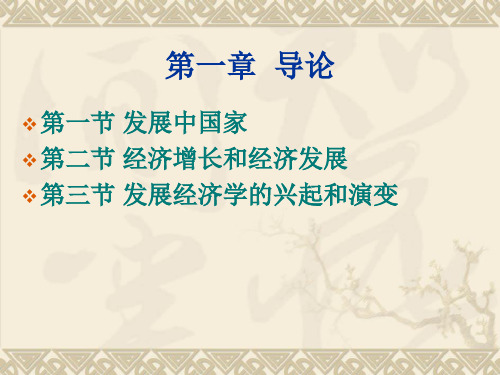
1251.5
1.2.3 经济发展的衡量指标
❖ 1.世界银行使用人均GNP这一简单的指标来衡量各 个国家的发展水平。优点:易于操作;缺陷:因为 它只是一个平均值,因此不能反映收入的分配状况。
Industry
Services
2005 13 0 4w 22 10
2005 46 10 28w 28 37
2005 41 90 68w 50 53
13
41
46
7
32
62
12
36
52
13
45
42
8
32
60
8
32
60
11
41
48
19
27
54
17
32
51
2
26
72
Household final cons. expenditure
1.1.3. 发展中国家的基本特征
1. 收入水平低下 2. 生活水平低下 3. 生产率水平低下 4. 人口增长率高、赡养负担重 5. 失业问题严重 6. 农业部门和农村人口所占比重大 7. 初级产品出口比重大而且品种单一 8. 二元经济结构显著 9. 国际关系中处于受支配的地位
9
劳动生产率的国际比较
❖ United Kingdom;
United States
6
7
Note: This table classifies all World Bank member economies, and all other economies with populations of more than 30,000. Economies are divided among income groups according to 2006 GNI per capita, calculated using the World Bank Atlas method. The groups are: low income (LIC), $905 or less; lower middle income (LMC), $906–3,595; upper middle income (UMC), $3,596–11,115; and high income, $11,116 or mor8e.
新结构经济学(林毅夫)课件
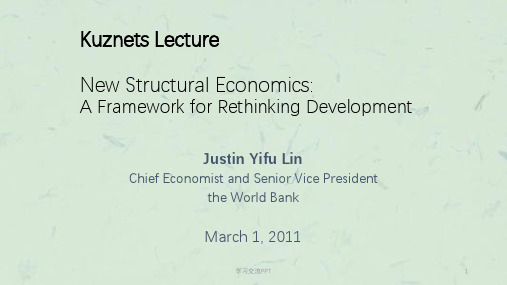
• Contributes to new theoretical and policy insights for economic development
Kuznets Lecture
New Structural Economics:
A Framework for Rethinking Development
Justin Yifu Lin
Chief Economist and Senior Vice President the World Bank
March 1, 2011
Market based economies with proactive role for government
Rethink Development
Structuralist Approach Focus on Market Failures: Import Substitution Strategy
学习交流PPT
1
Overview of Presentation
• Why do we need to rethink development
• The New Structural Economics
• Industrial Policy and Growth Identification and Facilitation: An application of new structural economics
Miserable results
新结构经济学
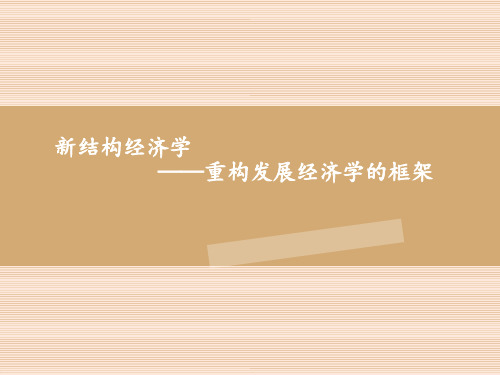
外生:在经济机制中受外部因素主要是政策因素影响,而非经济体系内部因素所决定
的变量。
基础设施:基础设施是指为社会生产和居民生活提供公共服务的物质工程设施,是
用于保证国家或地区社会经济活动正常进行的公共服务系统。它是社会赖以生存发展 的一般物质条件。
因势利导:顺着事情发展的趋势,加以引导。
目 录
货币政策
金融发展
3 4
利率政策完全有可能作为反周期的调控工具,通过鼓 励在萧条时期进行基础设置和产业升级投资,提高未 来的经济增速。 新结构经济学认为,每个给定发展水平的最优金 融结构可能取决于当时的主流产业结构、平均企 业规模和典型风险种类,而这些因素又进一步决 定于当时经济体的要素禀赋结构。
四、新结构经济学:一些政策洞见
2
对经济管理中关键工具的运用方式不同
旧结构经济学认为,政府对经济活动的系统性干预是从 “发展中国家”走向“工 业化国家”、实现现代化目标的核心手段,泛保护主义(如政府强加进口关税以 保护国内幼稚产业)、严格控制的汇率政策,以及在大多数产业部门设立国有企 业等都是这种系统性干预的组成部分。 新结构主义经济学视进口替代为发展中国家在发展过程中顺产业阶梯而上的自然 现象,只要替代的产业符合变化后的禀赋结构所决定的新的比较优势。
三、新结构经济学“新在哪里”
1
与以往方法的异同
(1)相似性:“新”与“旧”结构经济学都以发展中国家与发达国家之间的结构 性差异为基础,并且都承认政府在协助经济从较低发展水平向较高水平提升时所 起到的积极作用。 (2)差异性:就政府的目标和干预措施而言,新旧结构经济学却有着根本性的差 异。旧结构经济学支持发展中国家的政府采用违背经济体比较优势的发展政策, 通过行政手段和价格扭曲措施来优先发展资本密集型产业,而新结构经济学则强 调市场对于资源配置的中心作用,并认为政府应该在产业升级过程中对企业所面 临的外部性和协调问题起到因势利导的作用。
新结构经济学——重构发展经济学的框架
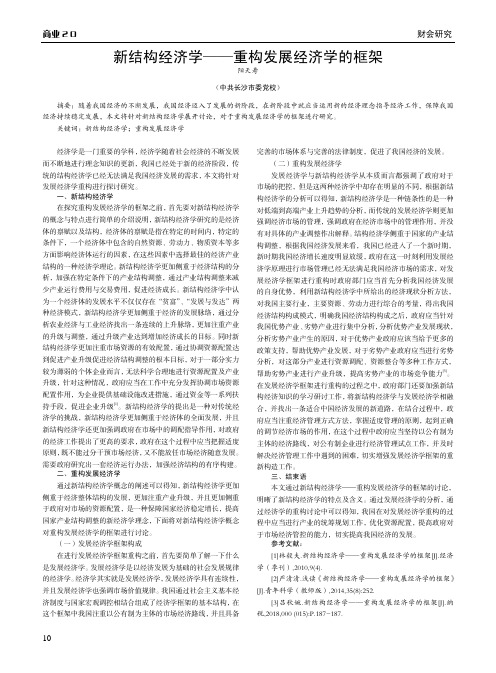
商业2.0 财会研究10新结构经济学——重构发展经济学的框架阳天寿(中共长沙市委党校)摘要:随着我国经济的不断发展,我国经济迈入了发展的新阶段,在新阶段中就应当运用新的经济理念指导经济工作,保障我国经济持续稳定发展,本文将针对新结构经济学展开讨论,对于重构发展经济学的框架进行研究。
关键词:新结构经济学;重构发展经济学经济学是一门重要的学科,经济学随着社会经济的不断发展而不断地进行理念知识的更新,我国已经处于新的经济阶段,传统的结构经济学已经无法满足我国经济发展的需求,本文将针对发展经济学重构进行探讨研究。
一、新结构经济学在探究重构发展经济学的框架之前,首先要对新结构经济学的概念与特点进行简单的介绍说明,新结构经济学研究的是经济体的禀赋以及结构,经济体的禀赋是指在特定的时间内,特定的条件下,一个经济体中包含的自然资源、劳动力、物质资本等多方面影响经济体运行的因素,在这些因素中选择最佳的经济产业结构的一种经济学理论。
新结构经济学更加侧重于经济结构的分析,加强在特定条件下的产业结构调整,通过产业结构调整来减少产业运行费用与交易费用,促进经济成长。
新结构经济学中认为一个经济体的发展水平不仅仅存在“贫富”、“发展与发达”两种经济模式,新结构经济学更加侧重于经济的发展脉络,通过分析农业经济与工业经济找出一条连续的上升脉络,更加注重产业的升级与调整,通过升级产业达到增加经济成长的目标。
同时新结构经济学更加注重市场资源的有效配置,通过协调资源配置达到促进产业升级促进经济结构调整的根本目标,对于一部分实力较为薄弱的个体企业而言,无法科学合理地进行资源配置及产业升级,针对这种情况,政府应当在工作中充分发挥协调市场资源配置作用,为企业提供基础设施改进措施,通过资金等一系列扶持手段,促进企业升级[1]。
新结构经济学的提出是一种对传统经济学的挑战,新结构经济学更加侧重于经济体的全面发展,并且新结构经济学还更加强调政府在市场中的调配指导作用,对政府的经济工作提出了更高的要求,政府在这个过程中应当把握适度原则,既不能过分干预市场经济,又不能放任市场经济随意发展。
- 1、下载文档前请自行甄别文档内容的完整性,平台不提供额外的编辑、内容补充、找答案等附加服务。
- 2、"仅部分预览"的文档,不可在线预览部分如存在完整性等问题,可反馈申请退款(可完整预览的文档不适用该条件!)。
- 3、如文档侵犯您的权益,请联系客服反馈,我们会尽快为您处理(人工客服工作时间:9:00-18:30)。
四、新结构经济学:一些政策洞见
1 财政政策
从新结构经济学的角度来看,反周期的财政政策对于发展中国家则是合 适的,这些国家的政府需要通过提供至关重要的基础设施来在产业结构 升级中发挥重要作用,于是衰退将成为进行基础设施投资的绝佳机会。
2 资源丰富国
家的公共租 金管理政策
新结构经济学提倡从资源商品收入中拿出合理的一部分用于 人力资本、基础设置与资源资本的投资,以对产业多样化与 产业升级提供因势利导的支持。
3 货币政策
利率政策完全有估计作为反周期的调控工具,通过鼓舞 在萧条时期进行基础设置与产业升级投资,提高未来的 经济增速。
4 金融发展
新结构经济学认为,每个给定发展水平的最优金 融结构估计取决于当时的主流产业结构、平均企 业规模与典型风险种类,而这些因素又进一步决 定于当时经济体的要素禀赋结构。
四、新结构经济学:一些政策洞见
2
对经济管理中关键工具的运用方式不同
旧结构经济学认为,政府对经济活动的系统性干预是从“发展中国家”走向“工业
化国家”、实现现代化目标的核心手段,泛保护主义(如政府强加进口关税以保护
国内幼稚产业)、严格控制的汇率政策,以及在大多数产业部门设立国有企业等都
是这种系统性干预的组成部分。
新结构主义经济学视进口替代为发展中国家在发展过程中顺产业阶梯而上的自然 现象,只要替代的产业符合变化后的禀赋结构所决定的新的比较优势。
所左右。
外生:在经济机制中受外部因素主要是政策因素影响,而非经济体系内部因素所决
定的变量。
基础设施:基础设施是指为社会生产与居民生活提供公共服务的物质工程设施,
是用于保证国家或地区社会经济活动正常进行的公共服务系统。它是社会赖以生 存发展的一般物质条件。
因势利导:顺着情况发展的趋势,加以引导。
5 外国资本
新结构经济学认为,外商直接投资是一种对发展中国家最为有利的外国 资本流动形式,因为它的目标就是通过发展与这些国家比较优势相一致 的产业而获利。
6 贸易政策
新结构经济学与新古典经济学一样,认为进出口内生取决于 经济体要素禀赋结构所决定的比较优势。
7 人力资本
需要进行认真的政策规 划,而且理应成为一个国家总体发展战略的重要组成部
林毅夫先生提出新结构经济学的理论框架,认为经济结构内生决
定于要素禀赋结构,并倡导以新古典经济学的方法来研究经济结构及
其变迁,以及政府、市场在此过程中所起的作用,以弥补当前发展经济
学的不足。
二、新结构经济学的主要内容
新结构经济学强调,在经济发展的过程中,必须发挥市场与政府的协同作用,同时,
政府的政策与各种制度安排必须考虑不同发展水平的结构性特征,这些结构性特征在特
第一
模型、市场范围、交易复杂程度以及不同的风险种类。因此,每一个特定的产业 结构都要求与之相习惯的基础设施来尽估计降低运行与交易成本。
第二
经济发展水平并非仅有“穷与富”或“发展中与发达”这两种离散情况,而是一条从低
收入农业经济一直到高收入工业化经济的连续频谱。
在每个给定的发展水平,市场是配置资源最有效率的机制,在市场机制以外,政
分。
五、参考文献
[1] 林毅夫、新结构经济学——重构发展经济学的框架 [J]、经济学(季刊),2010,10,第10卷第1期、
[2] 余 永 定 、 发 展 经 济 学 的 重 构 [J]、 经 济 学 ( 季 刊),2013,4,第12卷第3期、
感谢您的聆听!
目 录
Contents
1
发展经济学的发展过程
2 新结构经济学的主要内容
3 新结构经济学新在哪里
4
新结构经济学:一些政策洞见
一、发展经济学的发展过程
二战后,结构主义的观点占主流。强调政府失灵 及政府在改变经济结构、促进经济发展中的作 用。
20世纪70年代以后,转而以华盛顿共识为主流。强 调政府失灵,片面侧重市场的作用,同时忽视了对结 构及其变迁问题的研究。
第三
府必须在发展过程中发挥积极而重要的协调或提供基础设置改进以及补偿外
部性的作用,以促进产业的多样化以及升级。
三、新结构经济学“新在哪里”
1
与以往方法的异同
(1)相似性:“新”与“旧”结构经济学都以发展中国家与发达国家之间的结构性 差异为基础,同时都承认政府在协助经济从较低发展水平向较高水平提升时所起到 的积极作用。
别大程度上由各个发展中国家要素禀赋结构及其市场力量内生决定。而非旧结构主义
所假设的那样,是由权力分配或其她外生固有刚性条件所决定。
新结构经济学的要点: 一个经济体的禀赋及其结构在每一个特定的发展水平下是给定的,并随发展水平 不同而不同,因而经济体的最优产业结构也会随发展水平不同而不同。不同的产 业结构不仅意味着不同的产业资本密集度,还意味着不同的最优产业模型、生产
新结构经济学 ---重构发展经济学的框架
解释几个名词
要素禀赋理论:不同的商品需要不同的生产要素比例,而不同国家拥有的生产要
素相对来讲是不同的,因此,各国应生产那些能密集地利用其较充裕的生产要素的 商品,以换取那些需要密集地使用其稀缺的生产要素的进口商品。
内生:在经济体系内部由纯粹经济因素影响而自行变化的变量,通常不被政策因素
(2)差异性:就政府的目标与干预措施而言,新旧结构经济学却有着根本性的差异。 旧结构经济学支持发展中国家的政府采纳违背经济体比较优势的发展政策,通过行 政手段与价格扭曲措施来优先发展资本密集型产业,而新结构经济学则强调市场关 于资源配置的中心作用,并认为政府应该在产业升级过程中对企业所面临的外部性 与协调问题起到因势利导的作用。
